Tasking made easier with new project tracking and actioning capabilities
FeatureTaskingWe've been working hard to enhance our tasking capabilities and make your workflow more efficient. We've just launched two powerful new features to help you manage your projects and plan your next steps.
You can now filter your tasking orders by project name and/or tags to get a comprehensive, project-level view. See the combined progress of an entire project, including total ordered and delivered square kilometers, and download all coverage data at once.
You can also view and manage price quotations in bulk. Streamline your workflow by accepting or rejecting multiple quotes at the same time. These updates are designed to save you time and give you a clearer picture of your project's status.


New tasking dashboard: See all your order geometries at once!
TaskingFeatureWe've just released a new tasking dashboard, designed to give you a more powerful view of your projects. Here’s what it can do for you.
Display multiple AOIs and assets from your tasking orders and projects simultaneously on an interactive map. Instead of switching between individual AOIs, you'll get a consolidated map view of your entire project. Easily filter by name, status, or tags, or use the existing tabs that categorize orders by feasibility and quotation status to quickly find specific tasking orders.
Our team has done a great job making this feature especially visually appealing—go check it out!

Easily schedule repeat tasking orders
FeatureTaskingNeed to monitor the same AOI over multiple time periods? Now you can create repeat tasking orders in just a few clicks with UP42. After selecting the collection you need and uploading your AOI, simply choose between a one-time tasking or a repeat schedule across multiple intervals. It’s a faster, more flexible way to monitor your project AOIs over time.

Maxar’s high resolution, frequent revisit data now available for tasking on UP42
TaskingFeatureWe’ve expanded UP42’s optical data portfolio with the most advanced commercial EO constellation in orbit. You can now access 30 cm and 50 cm resolution imagery from Maxar’s WorldView, WorldView Legion, and GeoEye-1 satellites. Maxar provides a wide range of spectral bands and stereo tasking options, with global coverage and up to 15 daily revisits to ensure consistent data collection.
Task Maxar on the UP42 platform now or check out our documentation for more information.
GÖKTÜRK-1: very high resolution 50 cm imagery now available for tasking on the platform
TaskingFeatureWith the integration of GÖKTÜRK-1, our platform now offers increased tasking capacity, ensuring reliable access even during peak demand for high-resolution data. GÖKTÜRK-1 captures very high resolution imagery at 50 cm resolution every 3 days anywhere on the globe. Mono, stereo, and tri-stereo acquisition modes are supported.
Task GÖKTÜRK-1 on the UP42 platform or check out our documentation for more information.
Explore new use cases with Vexcel's aerial imagery
DataFeatureIn addition to Vexcel’s existing portfolio of very high resolution Oblique, Ortho, TrueOrtho aerial data, and elevation products, we've now integrated their discrete RGB imagery. Captured in the visible RGB spectrum, discrete imagery is minimally processed, closer to the raw data, and enriched with a more comprehensive set of metadata. This provides you with more flexibility when processing the imagery for your specific use case.
Vexcel's discrete imagery is also readily available for emergency response, as demonstrated by the availability of imagery after Hurricane Milton. Furthermore, additional metadata and image previews are now available across all Vexcel products, enabling more advanced applications like 3D reconstruction.

Preview multiple footprints simultaneously in the catalog
FeatureDataEasily explore all available scenes for your AOI when searching archive imagery from a specific provider. View multiple scene footprints at a glance to streamline your search and selection process.
What's next? The option to view multiple previews alongside the footprints, making your workflow even more efficient.

Save tasking order parameters as templates
FeatureTaskingIf you’re placing multiple tasking orders with the same parameters, we’ve made it easier for you. You can now create and save order parameters as templates, then reuse them for future orders. These templates are associated with a specific collection and can include parameters like cloud cover, processing level, incidence angle, etc.
This feature simplifies your tasking process, saving valuable time and effort when placing complex orders. Additionally, the template library can serve as a reference point for your organization, allowing multiple members to leverage saved templates for various use cases and needs.

We're upgrading to Mapbox!
FeatureWe are thrilled to announce the integration of Mapbox into the UP42 platform, enhancing your experience with more intuitive and visually engaging maps. This initial rollout impacts static maps across the console, including key areas like order details (catalog and tasking), asset details, and STAC item lists/ details in data management.
Take a look at a tasking order example below to see the new colors in action: a gray polygon or point marker now indicates the ordered geometry, whereas a blue polygon indicates the footprint of the acquired assets.
![]()

Stay tuned for future updates to our dynamic maps!
Planet's frequent-revisit, very high resolution satellite data now available on the UP42 platform
FeatureTaskingDataWe have significantly expanded our optical data portfolio with the integration of Planet SkySat, the world’s largest constellation of high resolution Earth observation satellites. With 15 SkySat satellites in orbit, Planet offers one of the most frequent revisit capabilities in the commercial sector, capturing insights multiple times per day at 50 cm resolution.
You can now access Planet's high resolution, high cadence data, including sub-daily collections in some areas. Ordering Planet's data through our platform also means you benefit from advanced tasking automation, harmonized data formats through STAC, scalable API ordering and processing of both archived and new images.
Order archive SkySat imagery or task a satellite.
Read our press release or find out more about the partnership here.
Introducing Wyvern: hyperspectral satellite imagery now available on UP42 tasking
FeatureTaskingWe’re proud to announce Wyvern as our first-ever hyperspectral partner.
Their Dragonette-1 hyperspectral images are acquired by a medium resolution (5.30 m) optical satellite every 2 days anywhere on the globe. They offer a whopping 23 spectral bands, for detailed analysis of crops, oil well and mine reclamation, and plenty of other cool use cases.

Task Dragonette-1 on the UP42 platform now or check out our documentation for more information.
Check tasking opportunities and feasibility before ordering
TaskingFeatureWe understand the importance of having a clearer timeline for your tasking orders. To enhance your planning process, we’re excited to introduce our new feature that provides clarity on potential tasking opportunities and the need for a feasibility study for your order.
Now you can view potential timeslots for capturing your Area of Interest (AOI) based on your chosen collection and order parameters. This lets you plan and manage your projects better by getting visibility into when your tasking order might be fulfilled. Additionally, you will be able to see immediately whether a feasibility study is required for your order.
Please note that this is a beta release, currently available for limited collections. The timeslots presented are indicative and not guaranteed. Your feedback is crucial as we refine and expand the tasking opportunities feature to cover all our collections. We look forward to hearing your thoughts and improving this feature to better serve your needs.

Search the catalog for the remaining parts of tasking orders
TaskingWe’re excited to announce an enhancement to your tasking order tracking capabilities. Our latest release lets you directly search our catalog for archive imagery covering pending geometries of your tasking order. If your tasking order is delayed for some reason, you can now easily switch over to the catalog to check the availability of archive imagery. This lets you make decisions faster and ensures the timely completion of complex tasking projects.

BlackSky's mono and stereo archive data now available on console and API
DataFeatureExplore BlackSky's high resolution 83 cm optical satellite imagery, acquired worldwide with a revisit rate of 7 times a day. The collection contains data from 2019 to the present and is available in both mono (georectified and orthorectified) and stereo mode (georectified only).
Place your order through our console or via our API. Or visit the UP42 marketplace to find out more.
Pléiades Neo HD15: highest resolution satellite imagery now on API and console
DataFeatureDesigned to enhance the visual rendering of Pléiades Neo 30 cm very high-resolution imagery, Pléiades Neo HD15 offers 15 cm spatial resolution, providing sharper details for easier interpretation. Catalog datasets are available starting from 2021.
Place your order through our console or via our API. Or visit the UP42 marketplace to find out more.
Beijing-3N 30 cm optical satellite imagery now available on console and API
DataFeatureDiscover our enhanced catalog experience
DataFeatureWe are continuously improving the way you discover data in the catalog. Now, it's easier than ever for us to showcase our growing selection of collections while enabling you to effortlessly explore and order the right data for your needs.
Explore the new tabs categorizing each data type and experience our enhanced filtering capabilities.
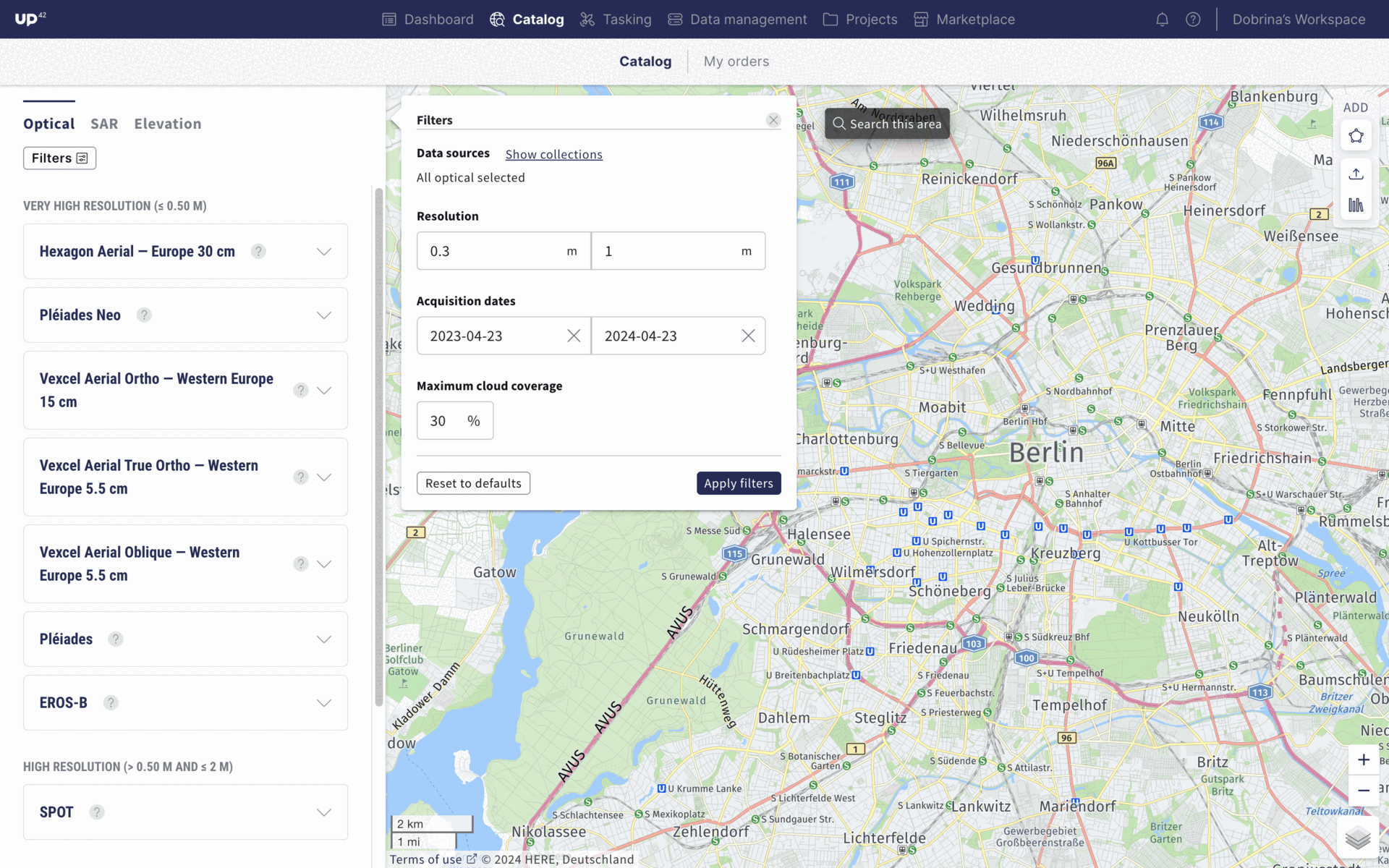
Effortless geometry management—now in data management
Data managementFeatureWe are excited to announce the seamless integration of our AOI management capabilities with data management. Save time and effort by managing your geometries directly within the catalog or data management interface.
What's new?
You can effortlessly draw or upload your AOIs, store them in your library, and make modifications such as renaming, adjusting coordinates, or generating new AOIs based on existing ones—in the catalog or data management. The convenience doesn't stop there! If you have AOIs stored in the catalog, you can easily access and utilize them within the data management interface. The shared library ensures consistency across the platform. Plus, when switching between tabs, your AOIs will remain on the page, no need to recreate them from scratch.
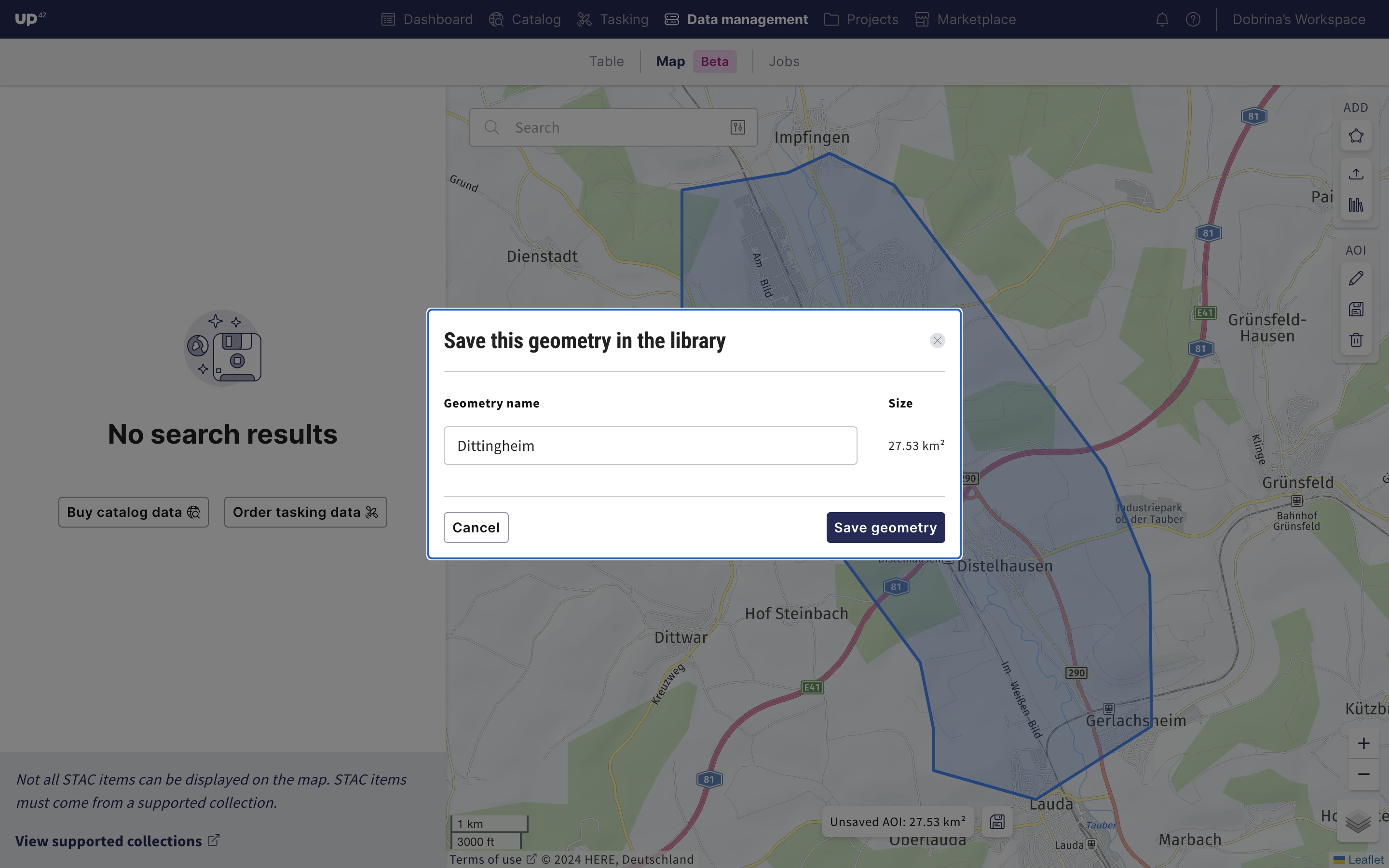
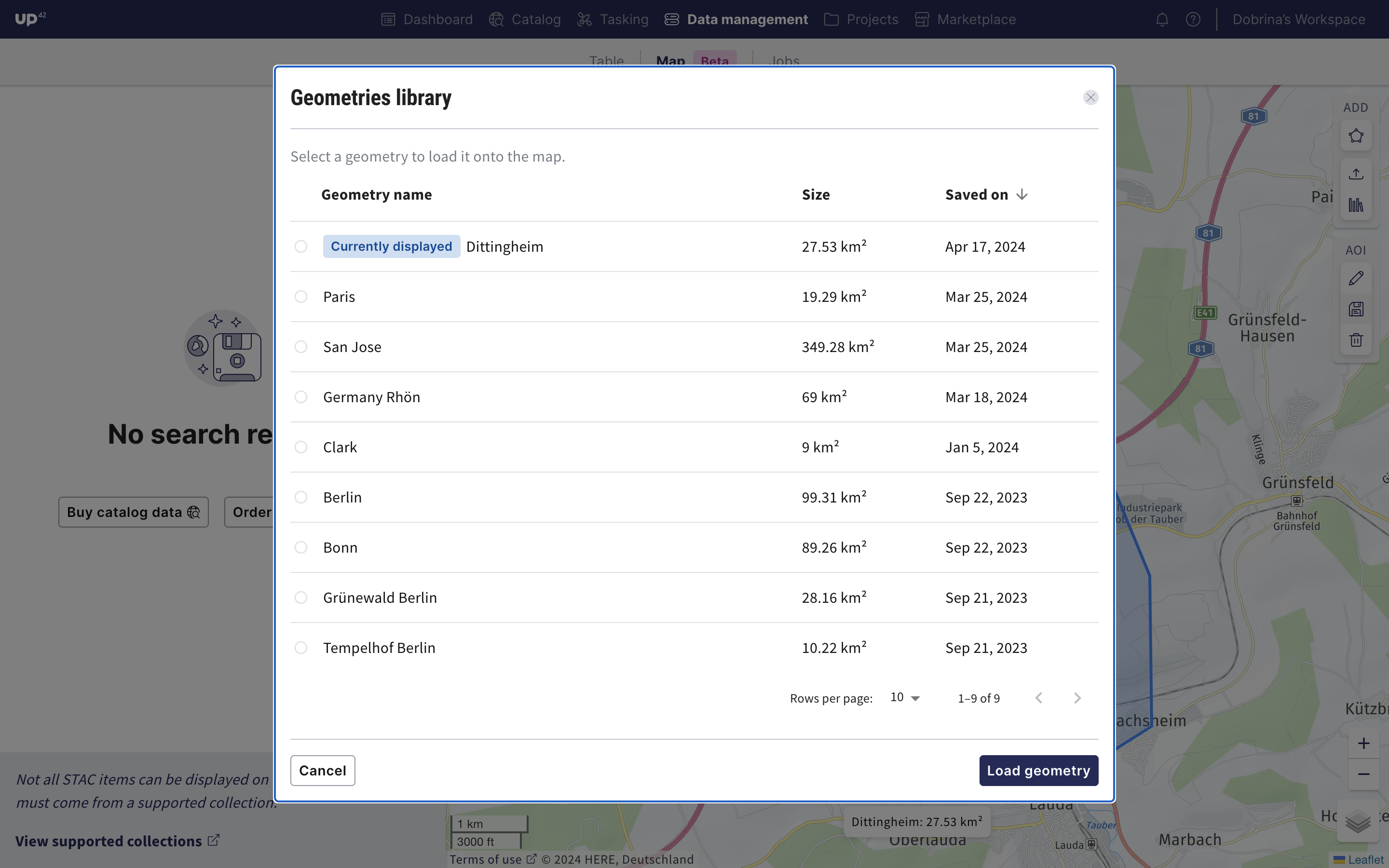
Go ahead and try our streamlined AOI management.
Hexagon Elevation DSM and EROS-C3 archive data from ISI now available on console and API
DataFeatureOur archive data offering keeps growing!
- Hexagon DSM offers very high resolution 30 cm and high resolution 60 cm digital surface models, acquired over North America and Europe. The collections contain data from 2014 to 2023.
- EROS-C3 offers very high resolution 30 cm optical satellite imagery, acquired worldwide with a daily revisit rate. Catalog datasets are available starting from 2021.
Expanding UP42's processing capabilities with algorithms from Orbital Insight, Spacept, and Airbus Agrimetrics
FeatureAnalyticsAs promised, we are re-introducing more processing algorithms to our platform. Get insights from your data in a more scalable way with:
Orbital Insight
Spacept
Airbus Agrimetrics
Recap—the benefits of our new processing platform
- We leverage STAC as an input and output for our processing engine
- See compatibility and price estimate immediately in the process
- Use the algorithms with as many compatible scenes as you want
- Process deliveries and access the output in your data management
- Easily trace your workflow from order to processed output
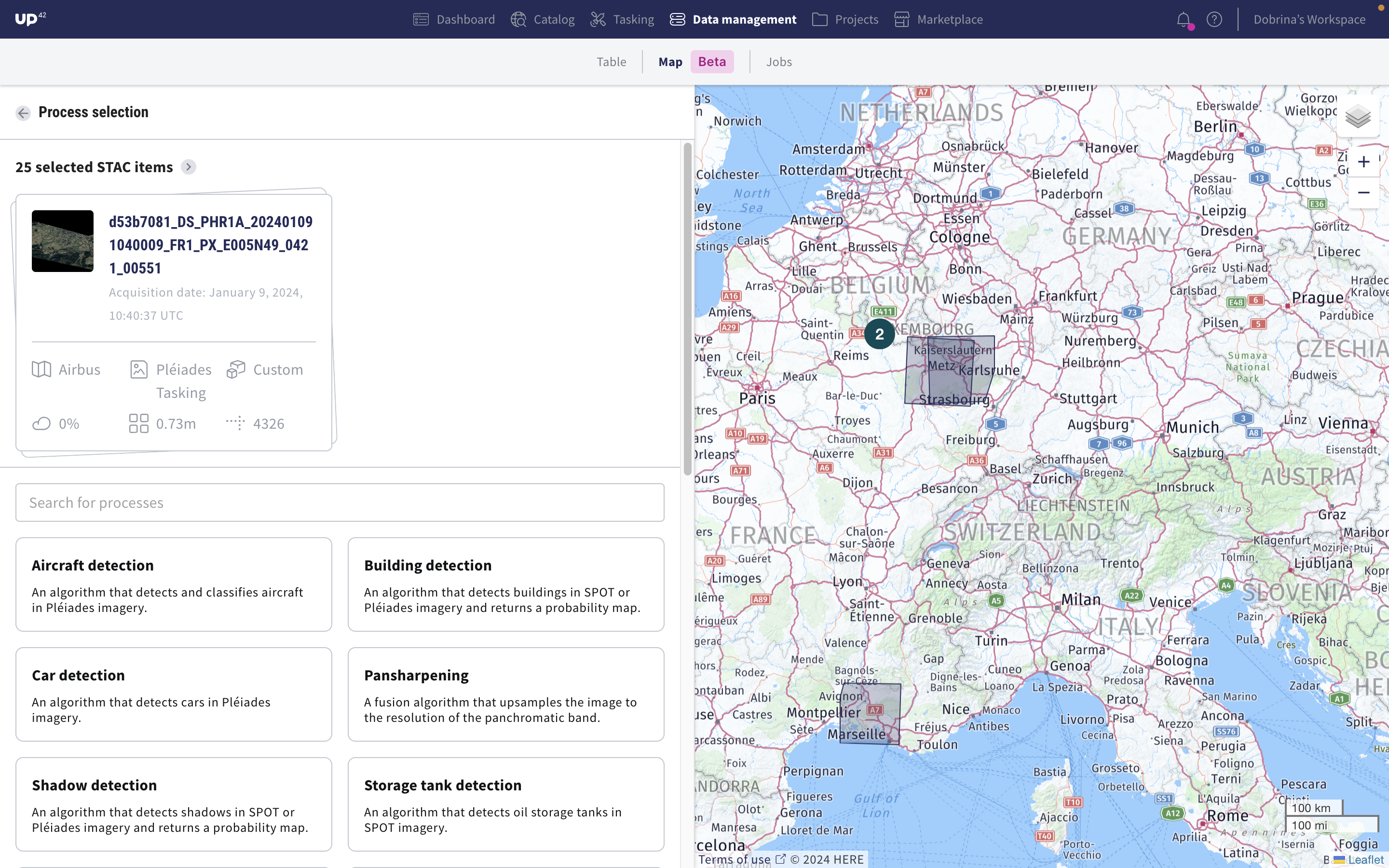
How can I process my data?
- In the console, go to data management, and in the map section, select the scenes you want to process
- The selected scenes are automatically validated before processing—no actions for you
- If a scene is not suitable for processing, we will tell you why and give you the option to remove it from the selection
- Run your selected processing algorithms on as many scenes as you want and track the status in the Jobs table
Alternatively, you can create a new processing job using the UP42 API.
Track the order coverage of your tasking orders
FeatureTaskingAfter you place a tasking order, it’s essential that you get a clearer idea of the status of your order. The new order coverage feature gives you the % of order that is already completed, and lets you download the remaining and covered AOI as KML files.
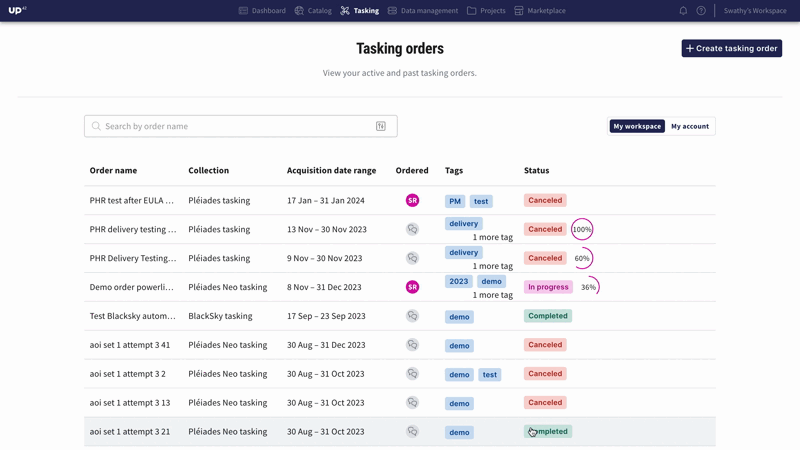
While placing complex tasking orders, you now get a more precise visual representation of the status of your order. As the assets are delivered for your order, you get a complete picture of the tasking order progress and the remaining areas that are still pending. This allows for better and faster internal decision-making while dealing with complex orders. You can also leverage the downloaded KML files as a starting point for new archive and tasking orders, saving time and ensuring accurate project planning and reporting.
EROS-B and EROS-C archive data from ISI now available on console and API
DataFeatureWe're adding two more very high resolution optical satellite imagery collections to the UP42 platform!
- EROS-B offers very high resolution 50 cm optical satellite imagery, acquired worldwide with a revisit rate of 2 days. Catalog datasets are available starting from 2006.
- EROS-C offers very high resolution 30 cm optical satellite imagery, acquired worldwide with a daily revisit rate. Catalog datasets are available starting from 2021.
Our new pansharpening algorithm: now on console too
FeatureAnalyticsTwo weeks ago we introduced our brand new pansharpening algorithm, our first advanced processing capability. You can now try it out directly on the console. Here is how:
- In the map section, select the scenes you want to process
- The selected scenes are automatically validated before processing—no actions for you
- If a scene is not suitable for processing, we will tell you why and give you the option to remove it from the selection
- In the case of pansharpening, scenes need to contain both panchromatic and multispectral bands
- You can then pansharpen all compatible images (as many as you want) and track the status in the new Jobs table
- That's it, you can now use the data for your downstream use case.
And the best part—pansharpening is currently free of charge.
How to pansharpen your images on the console
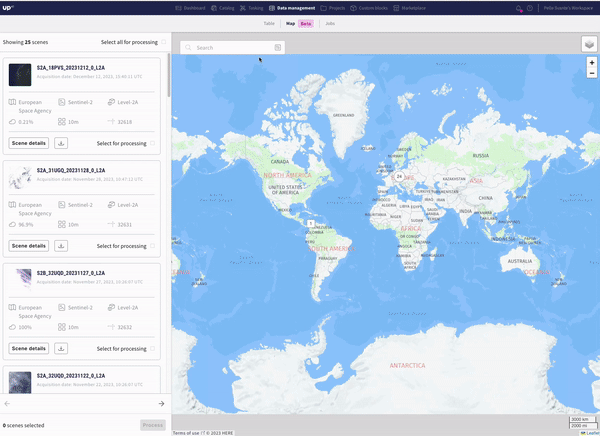
An exampe of a pansharpened image
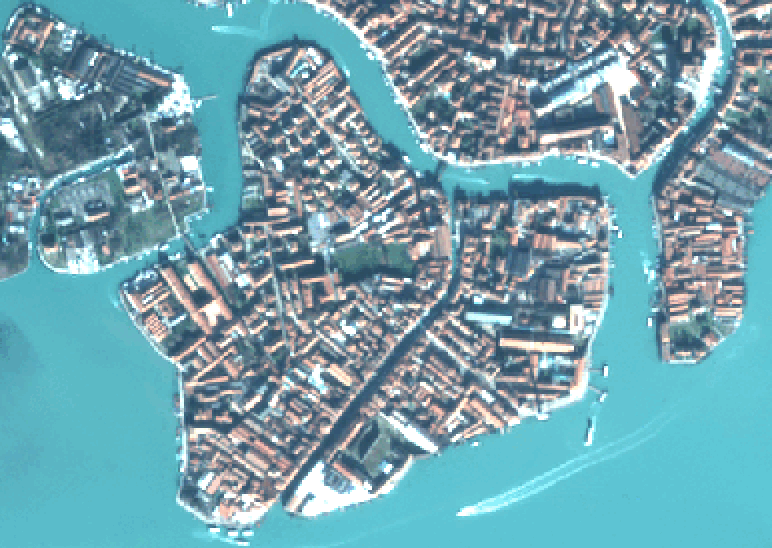 Pléiades, Airbus
Pléiades, Airbus
You can find more information about the requirements, input, and output in our detailed technical information. Try out pansharpening on the console today.
Brand new pansharpening algorithm: our first advanced processing capability
FeatureAnalyticsWe're fully integrating our analytics capabilities into the platform. You can now process any order delivery via our data management component. Most importantly, the output will be available in our STAC endpoints too, accessible through the same component. The process is more scalable—you can now apply our advanced processing capabilities to as many scenes as you want, as long as they’re compatible. It is also easier to scale—the end output will no longer be stored in the project itself, but in your data management component, making it easier to use the data for your downstream use case. Now let’s review a more practical example: pansharpening.
Short for panchromatic sharpening, pansharpening is an image fusion technique that increases the image to the resolution of the panchromatic band. It combines the higher-resolution panchromatic band with a lower-resolution multispectral band to yield a high spatial and spectral resolution image. You can now pansharpen your scenes directly on our platform using the Brovey method.
You will be able to automatically see which scenes are suitable for pansharpening, e.g., which scenes contain both panchromatic and multispectral bands. We will provide automatically optimized grey weights—no need to specify anything yourself.
The algorithm consumes and returns data and metadata that is STAC and CNAM compatible. It allows you to select an unlimited number of scenes and pansharpen them, instead of doing so individually for each scene. You can apply the algorithm by defining its STAC item ID. The pansharpened asset will be added to your account as a new STAC item, accessible via /v2/assets/stac endpoints.
 Pléiades, Airbus
Pléiades, Airbus
And the best part—pansharpening is currently free of charge. You can find more information about the requirements, input, and output in our detailed technical information. Try out pansharpening on the UP42 platform today.
New tasking flow with easier ordering and instant price estimation
TaskingWe’ve made some exciting new changes to the tasking ordering flow. Now you can view the list of available collections and their specifications upfront, upload geometries to validate compatibility, get an instant price estimate for your order, and view a complete summary of your order before submitting.
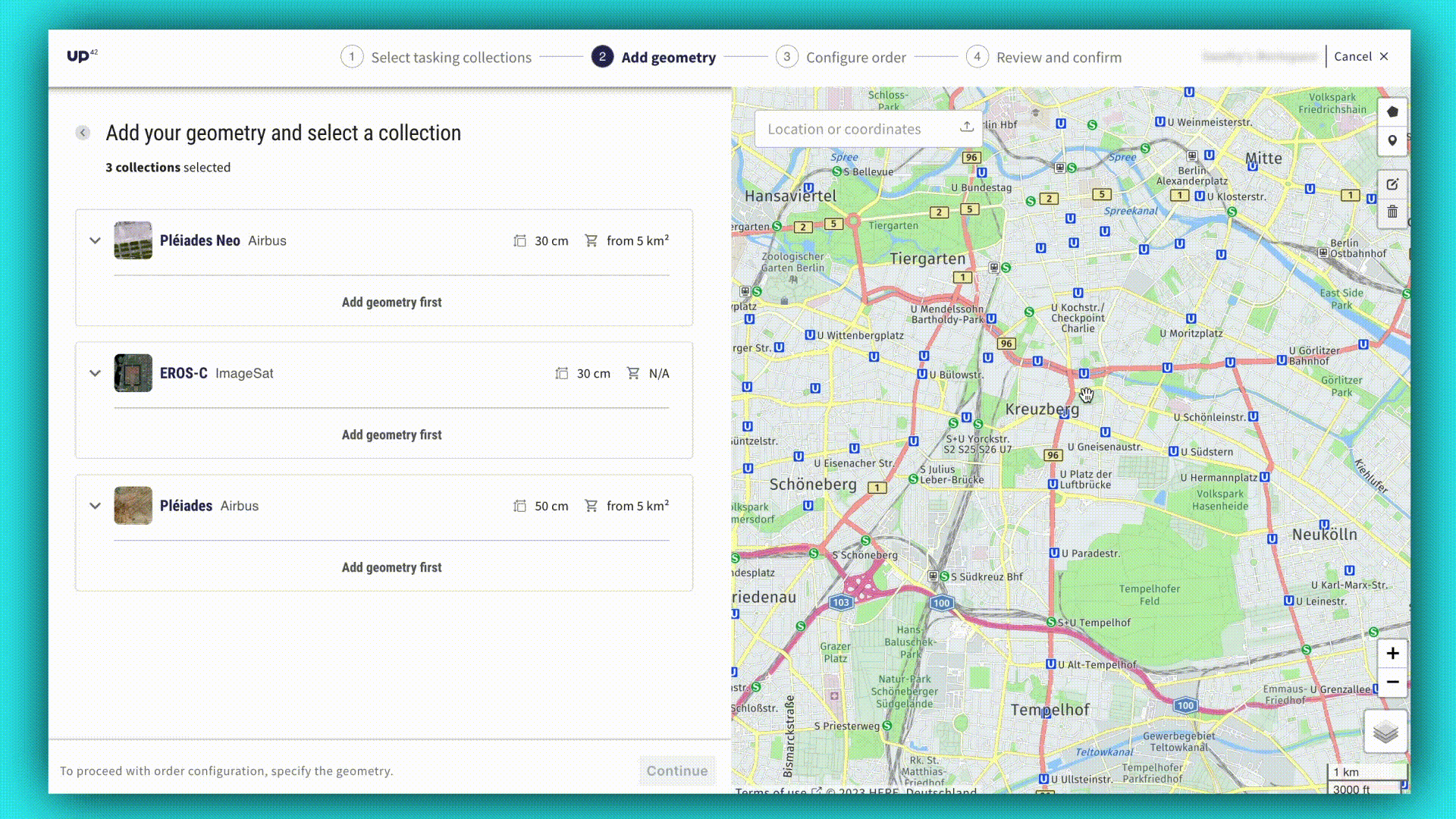
More very high resolution data from Pléiades Neo on the UP42 catalog
DataFeatureYou can now access the full Pléiades Neo archive via the UP42 catalog. What's new?
- Nearly 340 million km2 of Pléiades Neo data is now available on the platform—a 6-fold increase in the availability of very high resolution 30 cm data on the UP42 platform.
- The minimum order size has been lowered to 5 km2.
Access the full Pléiades Neo archive through our console or via our API.
Landsat 8 now available on API and console
DataFeatureWe're adding more open data to the UP42 platform! In addition to Sentinel-2, you can now access Landsat 8, an Earth observation mission from the Landsat programme of USGS and NASA. Benefit from free low resolution 30 m optical and thermal satellite data, acquired worldwide with a revisit rate of 16 days. The collection provides global coverage and contains data from 2013 to the present.
Place your order through our console or via our API.
Map it out: View and search for your scenes in our new data management map view
FeatureData managementIf you thought that our data management solution couldn't get any better—think again. You can now view your scenes on a map. How? Just use the search bar, enter a location and select a prompt from the drop-down list.
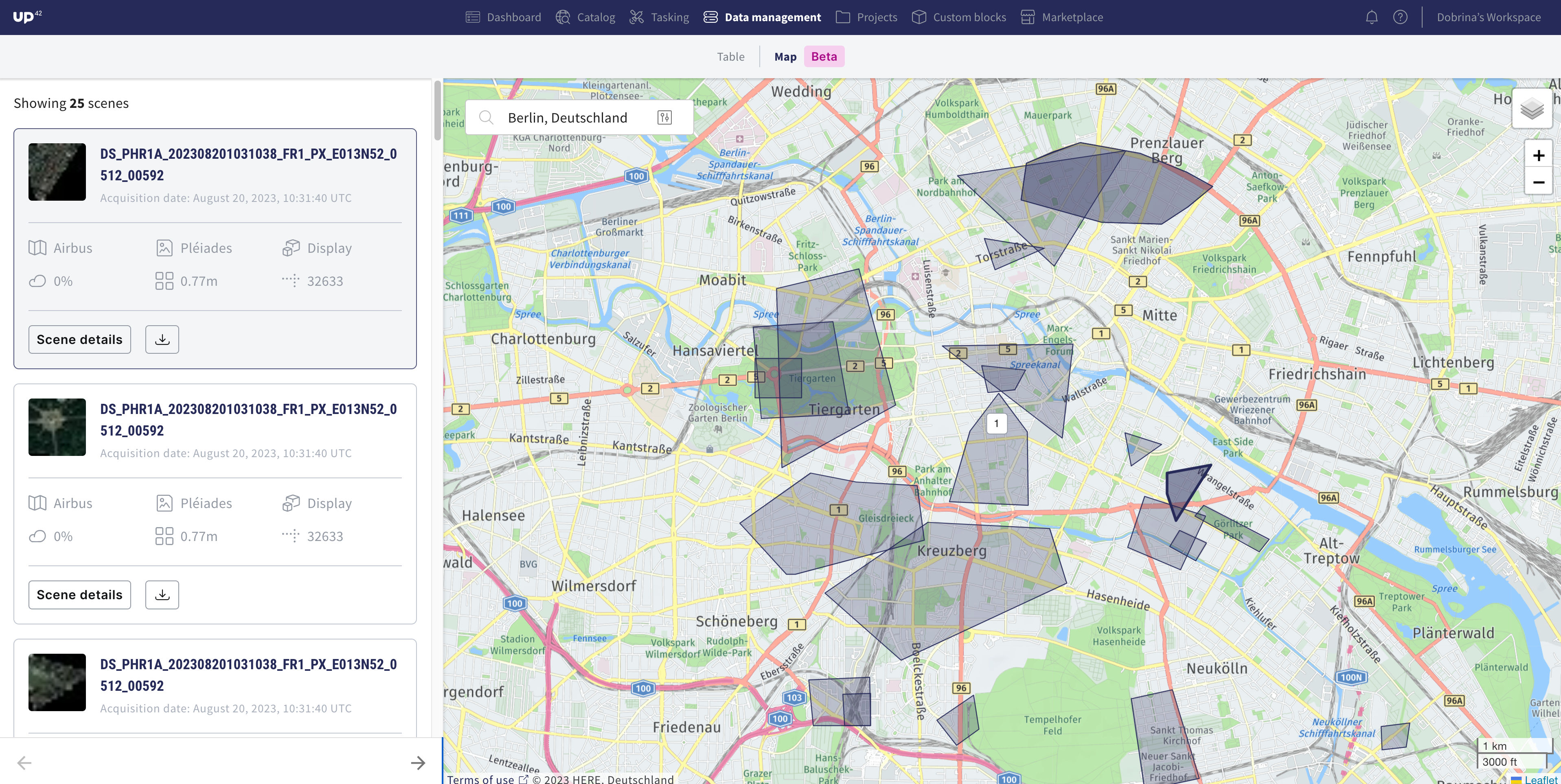
The map comes with even more filtering capabilities than the table view: creation and acquisition date, ground sampling distance, maximum cloud coverage, tag, order ID, product configuration, producer, collection, and source.
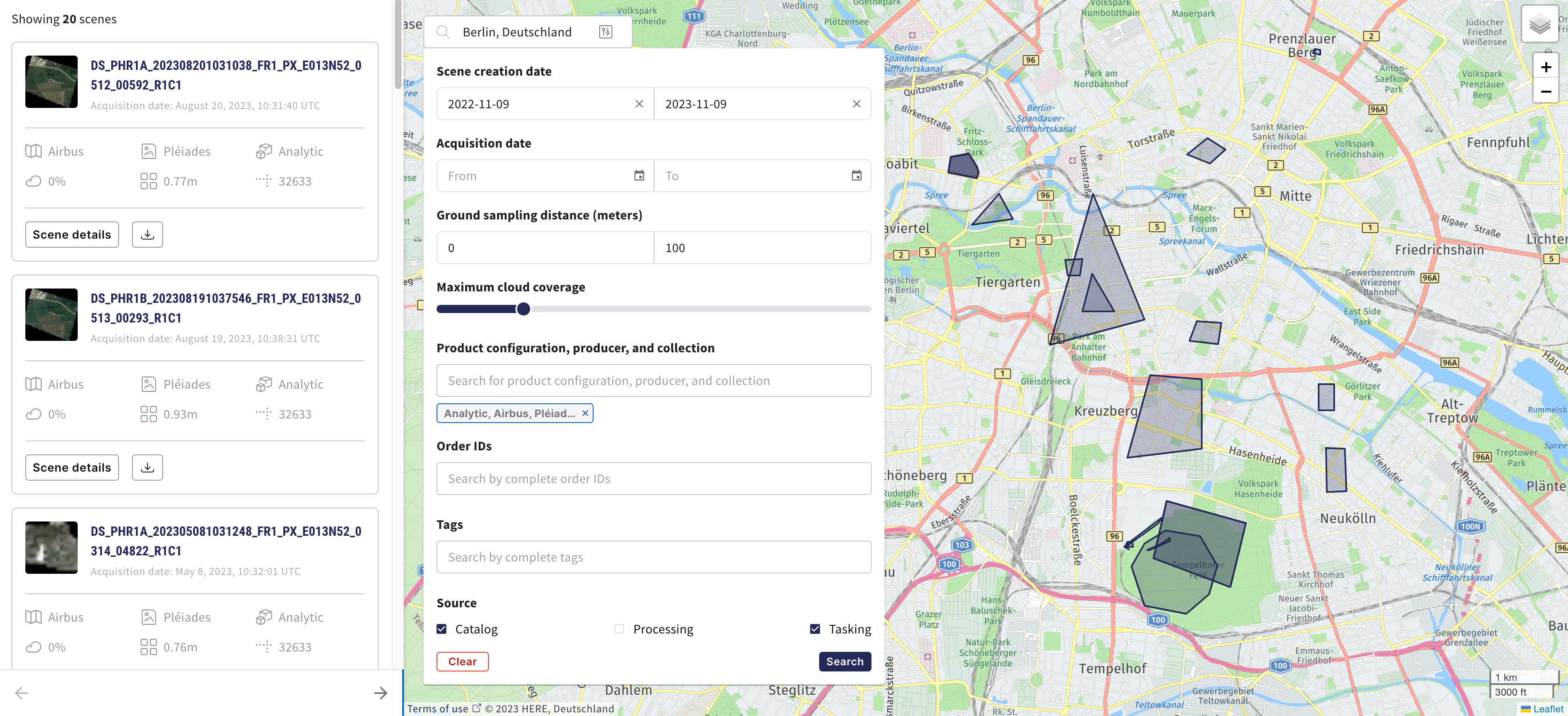
Our map view is still in Beta, so expect more features and updates from us soon. We will continue to invest in our data management capabilities, adding more value for our users and enabling easier downstream integrations.
Explore the map view now.
Simplified account management for admin users
FeatureYou can now easily make changes to your account without having to contact UP42's customer success team. As an admin of your account, you can remove a user with the Member role from their account.
- Open the console and click the upper right corner → Members.
- Find the user you want to remove. To remove a user, their role must be Member.
- Click on the symbol to the right of the user's current role to reveal options.
- Click Remove user and confirm you want to remove the user.
- The removed user's workspace and assets in storage will remain accessible to existing users.
As an admin and the last user of your account, you can also delete your account entirely from the Account page.
Check it out here.
Introducing effortless geometry management
FeatureDataNo more redrawing or re-uploading polygons: save time and effort when managing your geometries in the catalog!
- Store: Draw your AOI or upload a file, and save it in the library
- Use: Access your geometries at any time by loading them from your library
- Update: Modify the coordinates of previously created AOIs
- Recreate: Generate new AOIs by using existing ones as a starting point
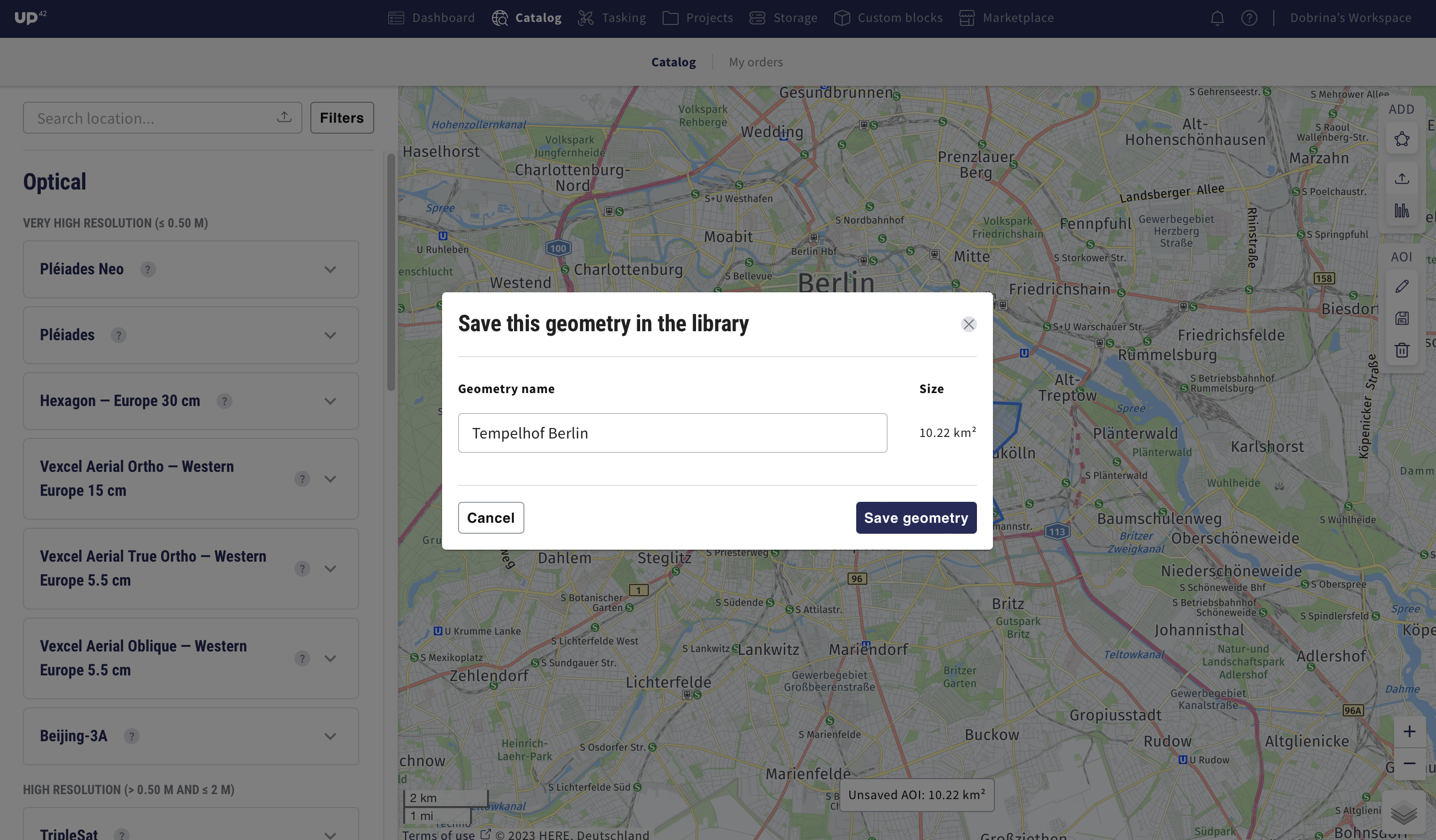
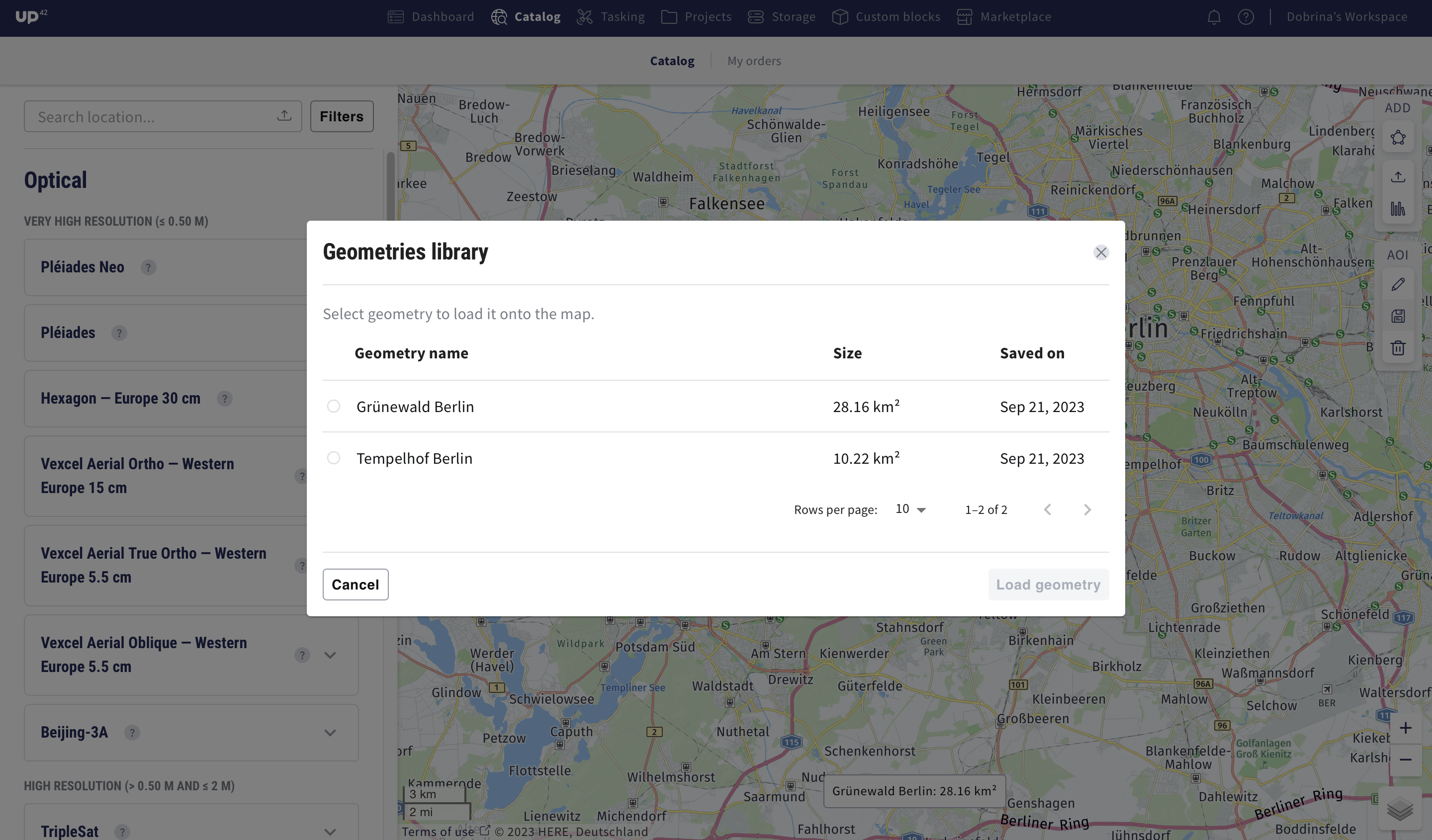
Try out our new geometry management capabilities in the catalog, or use the API.
Introducing UP42's cloud-native asset model: assets are now streamable and available in storage as decompressed individual geospatial features
FeatureData managementEarlier this year, UP42 adopted the STAC specification, which allows searching across multiple providers for geospatial assets with a common structure and set of metadata. Thanks to this, users can now do a STAC search in storage beyond simple attributes like date, time, and constellation.
And now, we’ve introduced a cloud-native asset model (CNAM) for assets in UP42 storage. Regardless of provider or delivery format, we will transform UP42 assets into individual geospatial features available for immediate download. Each file will be mapped as a STAC asset under a STAC item, and the original delivery accessible under STAC collection. CNAM will also convert all raster data into cloud optimized GeoTIFFs or COGs for short, and all vector masks into GeoJSONs to enable easier integrations. This will ensure consistency in how an asset is named, its media type (COGs or GeoJSON), and its role (e.g., data, metadata, previews, or masks).
The benefits:
- No need to download a compressed file - stream the part of the file you need
- No need to understand different delivery structures and naming conventions
- No need to access any files to see data and band information
- No need to do complex data transformations
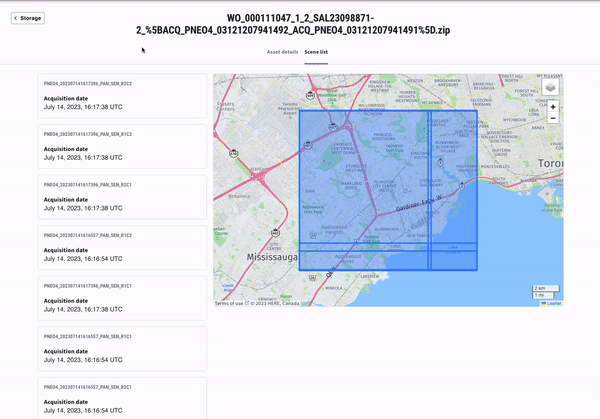
CNAM allows you to easily search for and work with the data. Read about the benefits of UP42's cloud-native asset model in the recent blog, or learn how to analyze STAC assets in our technical information.
21AT’s Beijing-3A archive data now available on API and console
DataFeatureView the footprint of scenes acquired for your tasking order
TaskingFeatureNow there is an easier way to monitor and stay on top of complex tasking orders. When a new asset is delivered to storage, the footprint of the acquired scenes are automatically displayed over the order AOI. You can go to the tasking order overview and click on a specific order to get this information. For complex orders with multiple AOIs, now you get a quick, intuitive overview of the acquired scenes.
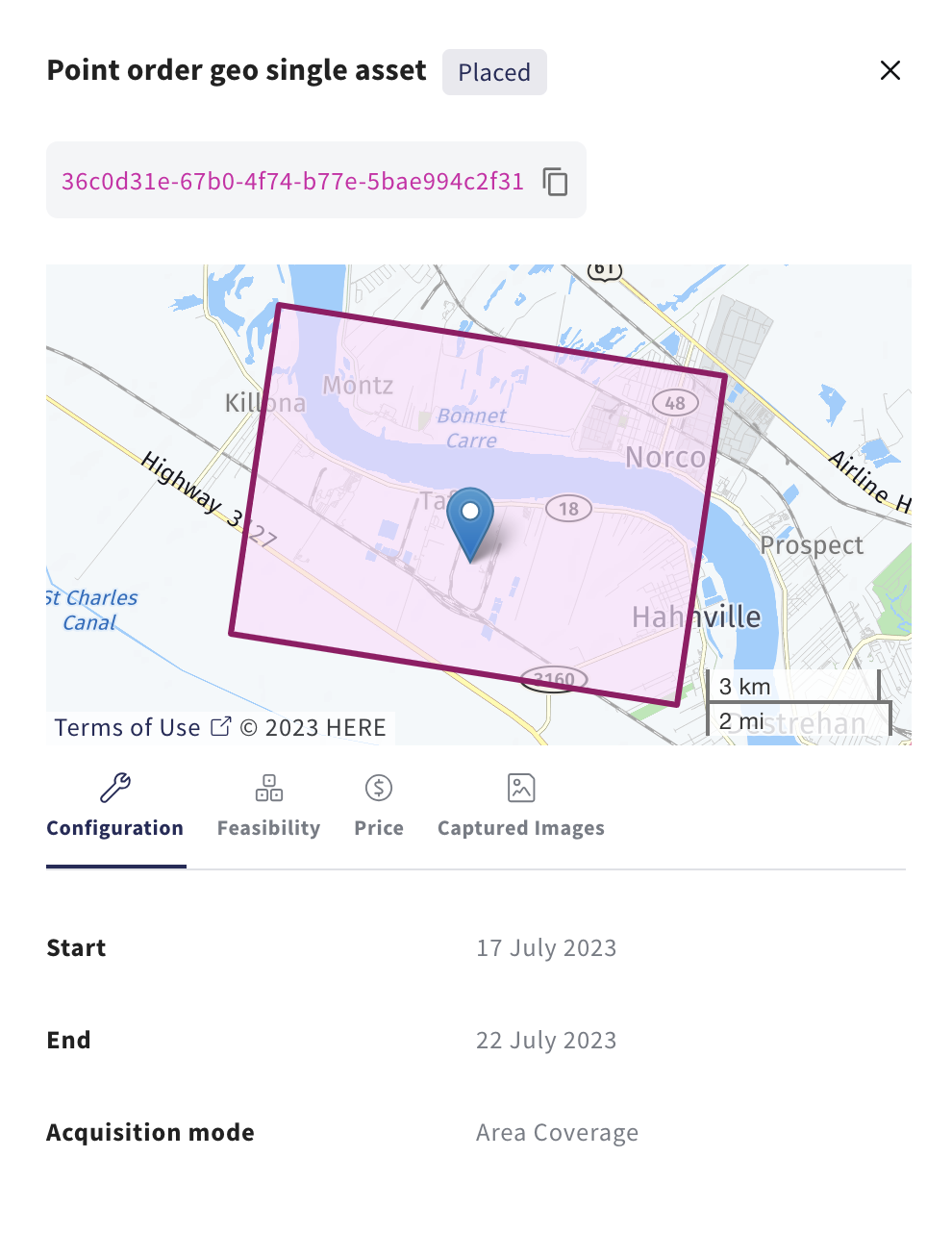
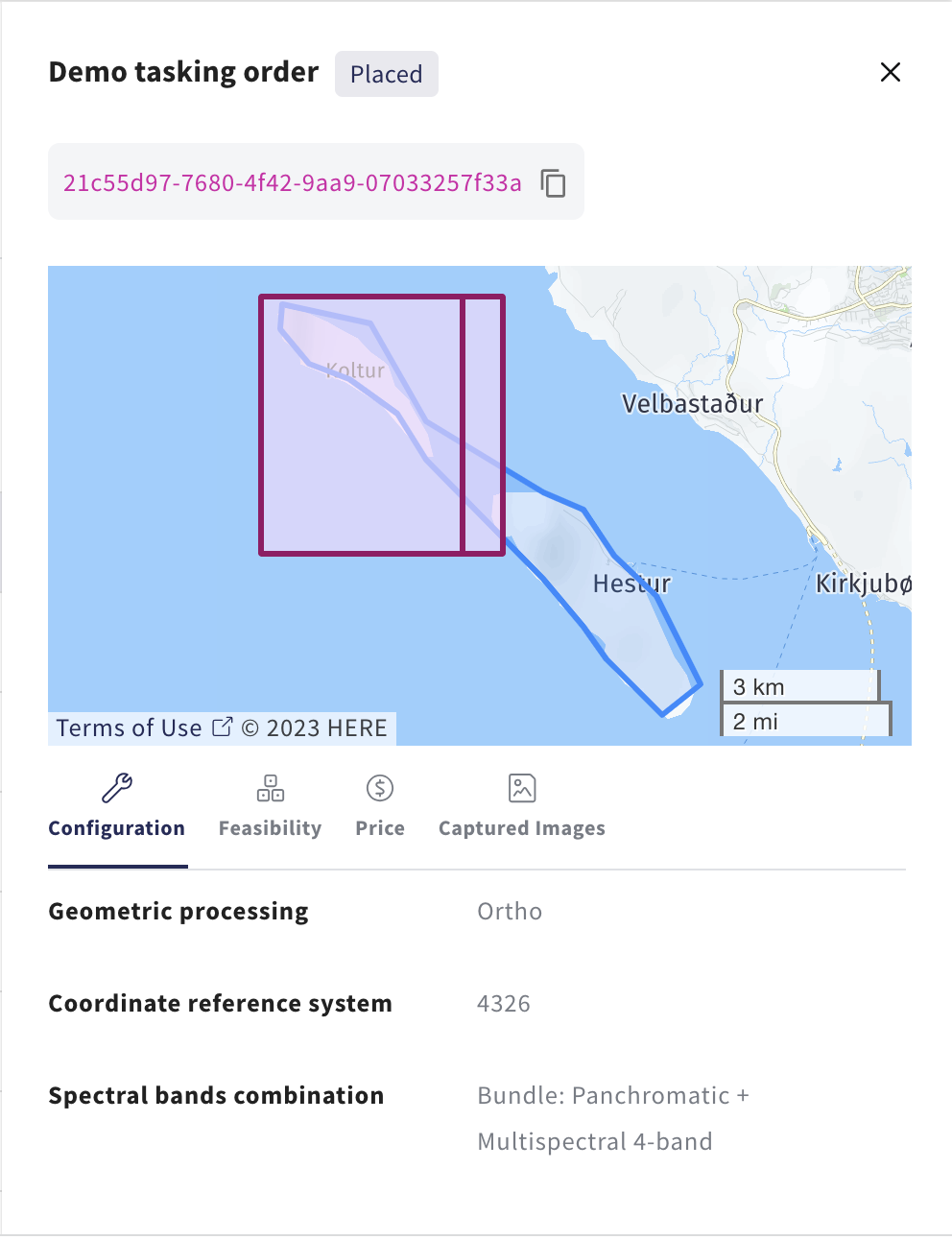
Check it out here.
Vexcel's aerial and elevation data available on API and console
DataFeatureVexcel's ultra high resolution aerial imagery, along with DTMs and DSMs, is now available on the UP42 platform. Vexcel delivers geospatial data products with high accuracy, spatial resolution, and consistency. The Vexcel Data Program is the largest in the world, capturing ultra-high-resolution imagery (starting at 5.5 cm resolution) and related geospatial data in more than 30 countries, including the U.S., Canada, U.K., Europe, Australia, New Zealand, and Japan.
Sample data now available on the UP42 platform
FeatureDataYou have a project and you need geospatial data? Wondering where to start? How about downloading free imagery directly on our platform. You can now find sample data for popular collections with more providers coming soon.
You can access sample data in two ways:
- Via your
DashboardclickingExplore all sample datato view the range of collections and providers available.
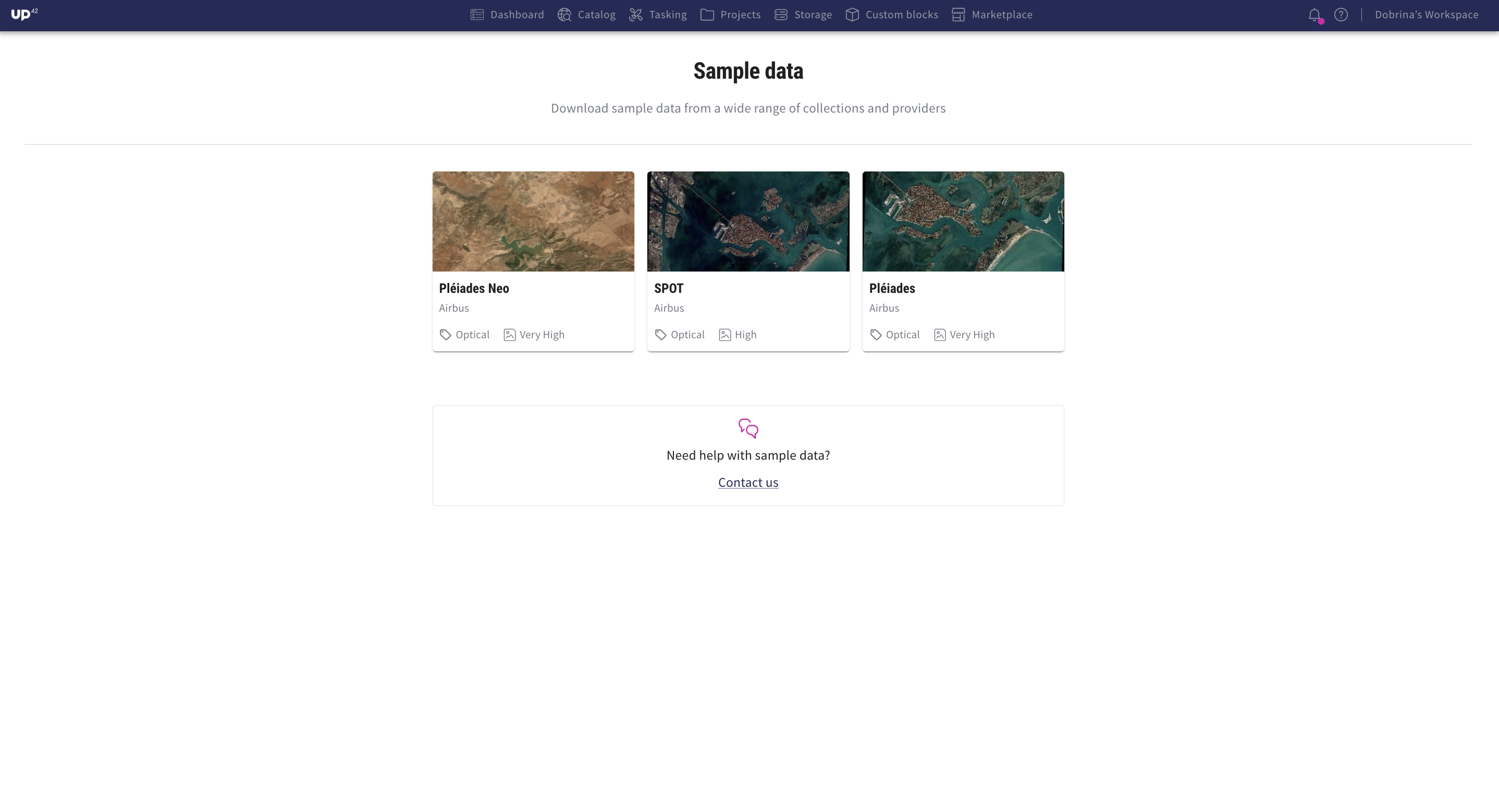
- Via the
Catalog, select a collection scene, click onSample data, accept the T&C and download your sample.
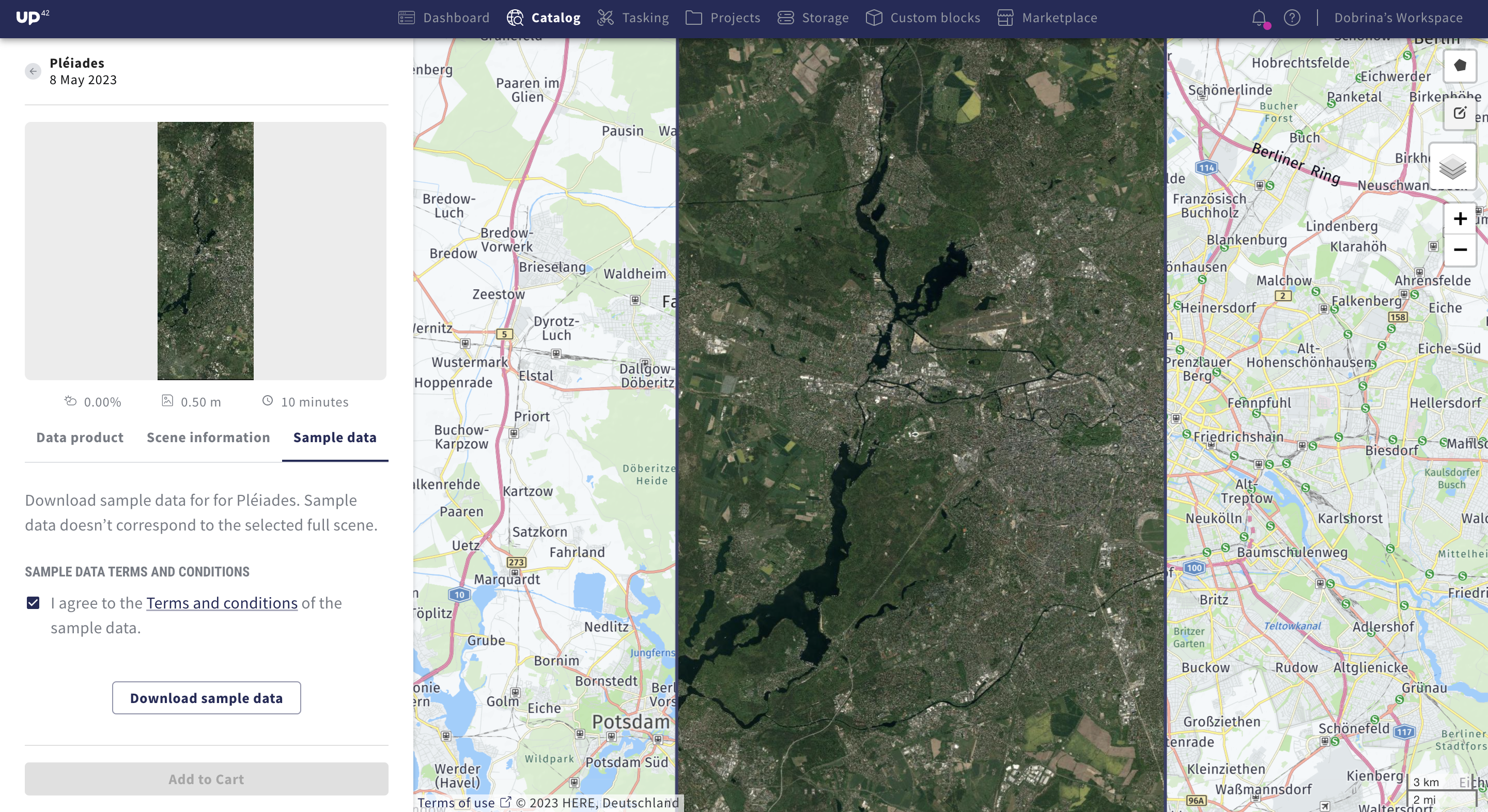
Use the data to understand the capabilities before committing credits to your specific AOI and use case.
Please note, that sample data doesn’t correspond to the selected full scene on the console. The sample might have limitations (e.g., coverage) compared to the commercial datasets available. It can however provide valuable insights and serve as a starting point for discovering data from multiple providers.
Flexible credit purchases for simplifying your transactions
FeatureCredits let you buy geospatial data, task imagery, or run analytics on the UP42 platform. We have introduced some changes to the console to make it faster and easier for our customers to purchase credits. In addition to selecting pre-set credit packages, you can now order a specific number of credits based on your business needs. The whole transaction can be completed within the console with a credit card, reducing the time spent on multiple email and invoice exchanges. By paying with credit cards, customers using currencies other than euros can avoid the need for international bank transfers to settle their payments.
Please note: You can place orders for credits starting from 10,000 and going up to 5 million. For orders beyond 5 million, you can get in touch with us directly.
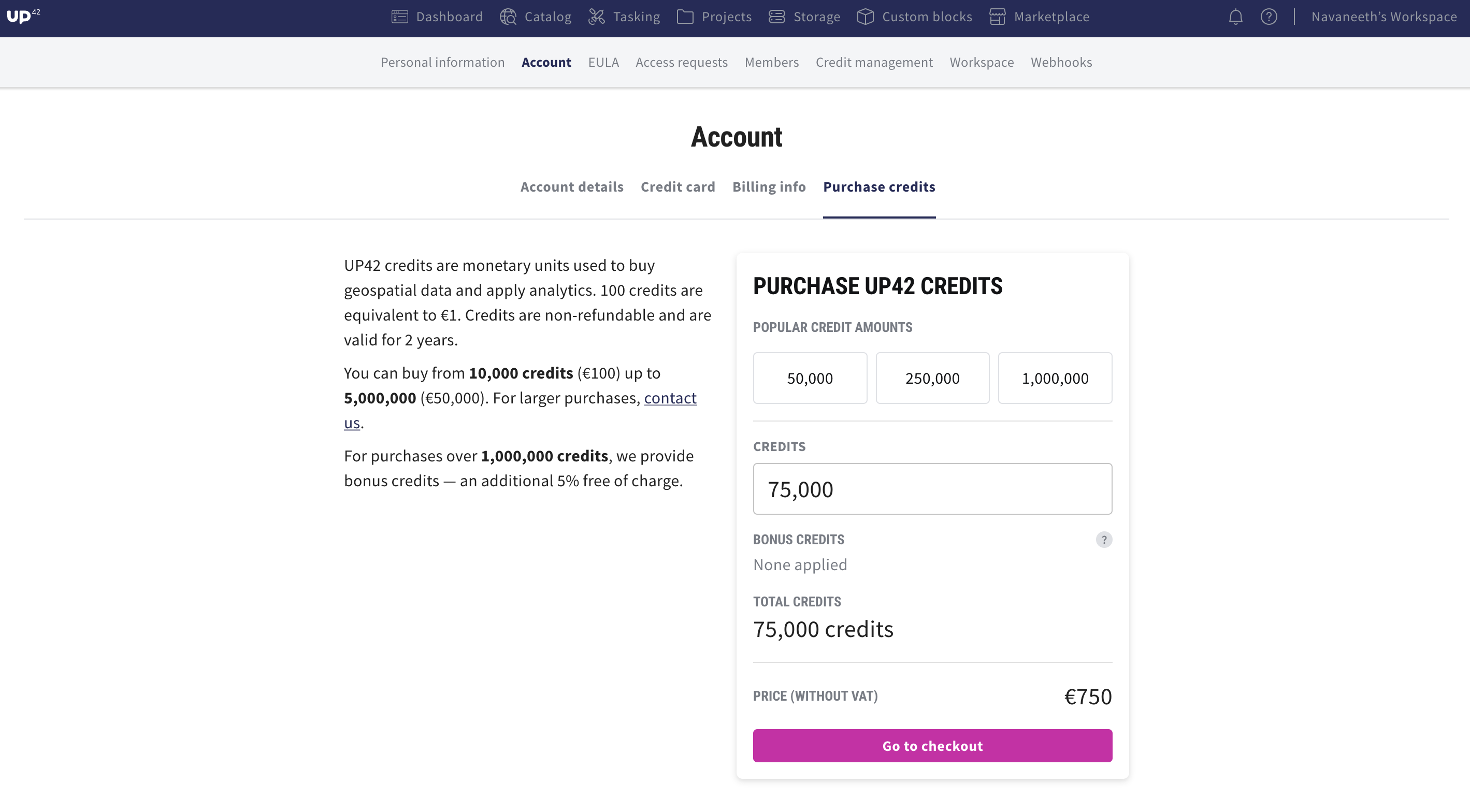
Check it out here.
Enhancing user experience with a refreshed catalog design
FeatureDataWe are delighted to unveil UP42's refreshed catalog User Interface (UI) design. This visual revamp enhances the discoverability of available collections, marking another step in our ongoing efforts to simplify the process of unlocking the potential of geospatial data.
Key features include:
- A new sidebar view, grouping data by collections (optical and non optical) and resolution (very high, high, medium)
- New grouping functionality (e.g., by resolution)
- A new
Search this areaview, updating the scenes for the chosen AOI
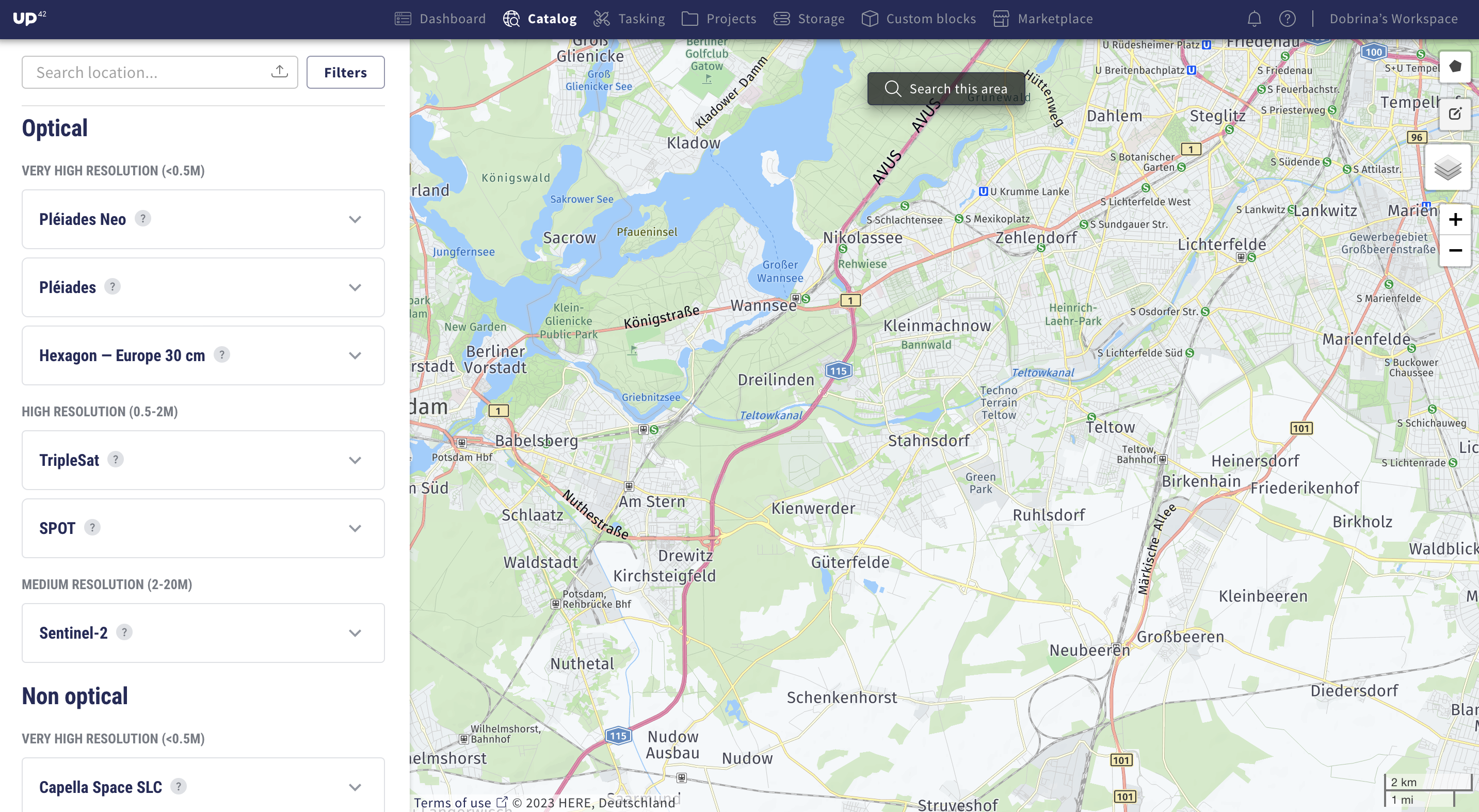
Our goal is to make every interaction as seamless as possible, so we will continue to improve your experience with UP42's catalog.
Asset details for every single asset in UP42 storage
FeatureData managementWe now provide you with an asset details page for every single asset in UP42 storage that has a valid STAC collection. Click on your asset to see the asset geometries of all scenes on a map, get information on product configuration, type of data and modality, or manage custom titles and tags given to your assets.
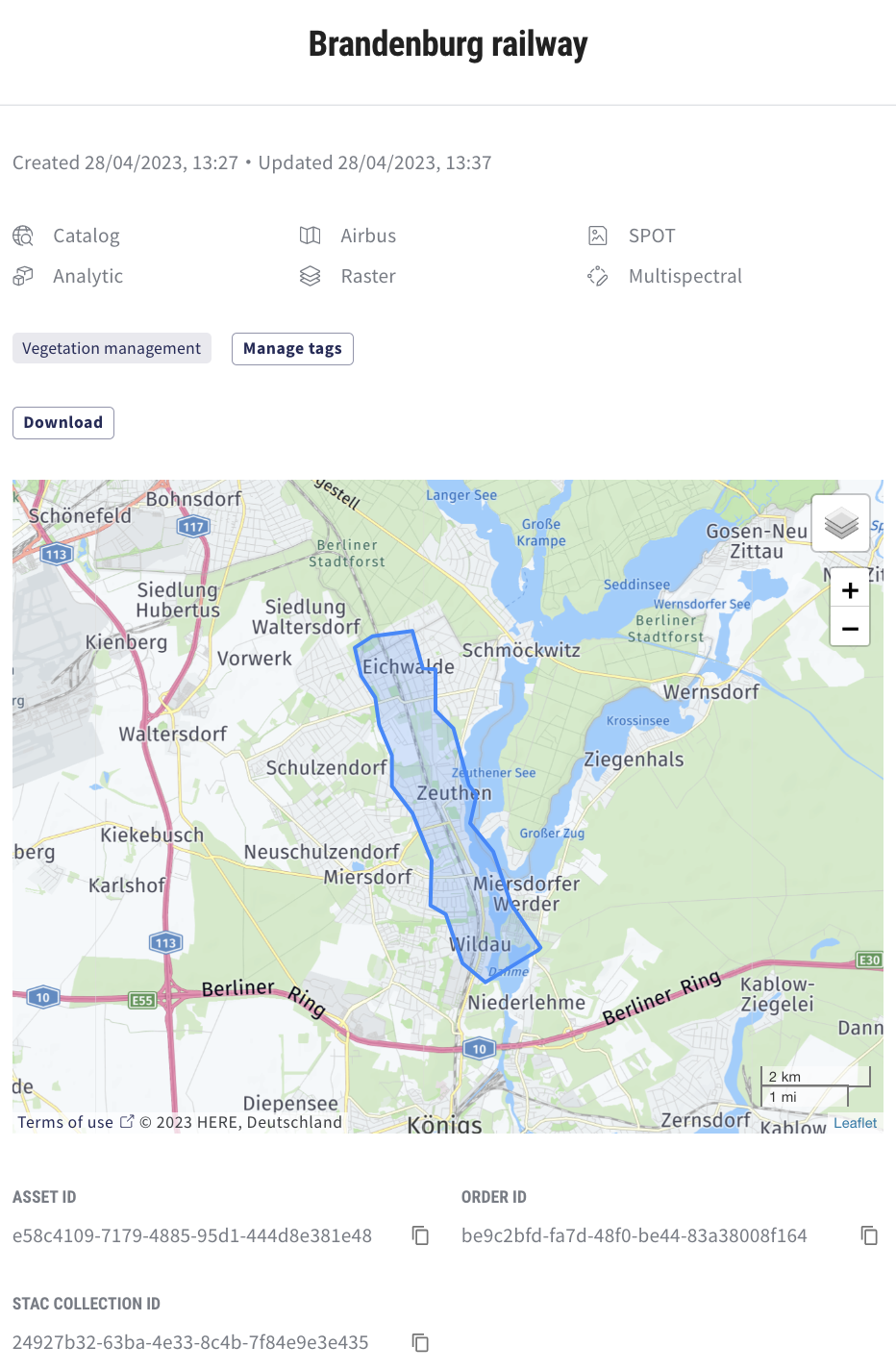
This makes it easier for you to validate the geometries delivered for tasking and archive orders. You can also find an adapted SDK/ API code snippet to access and download assets, and integrate them into your pipeline.
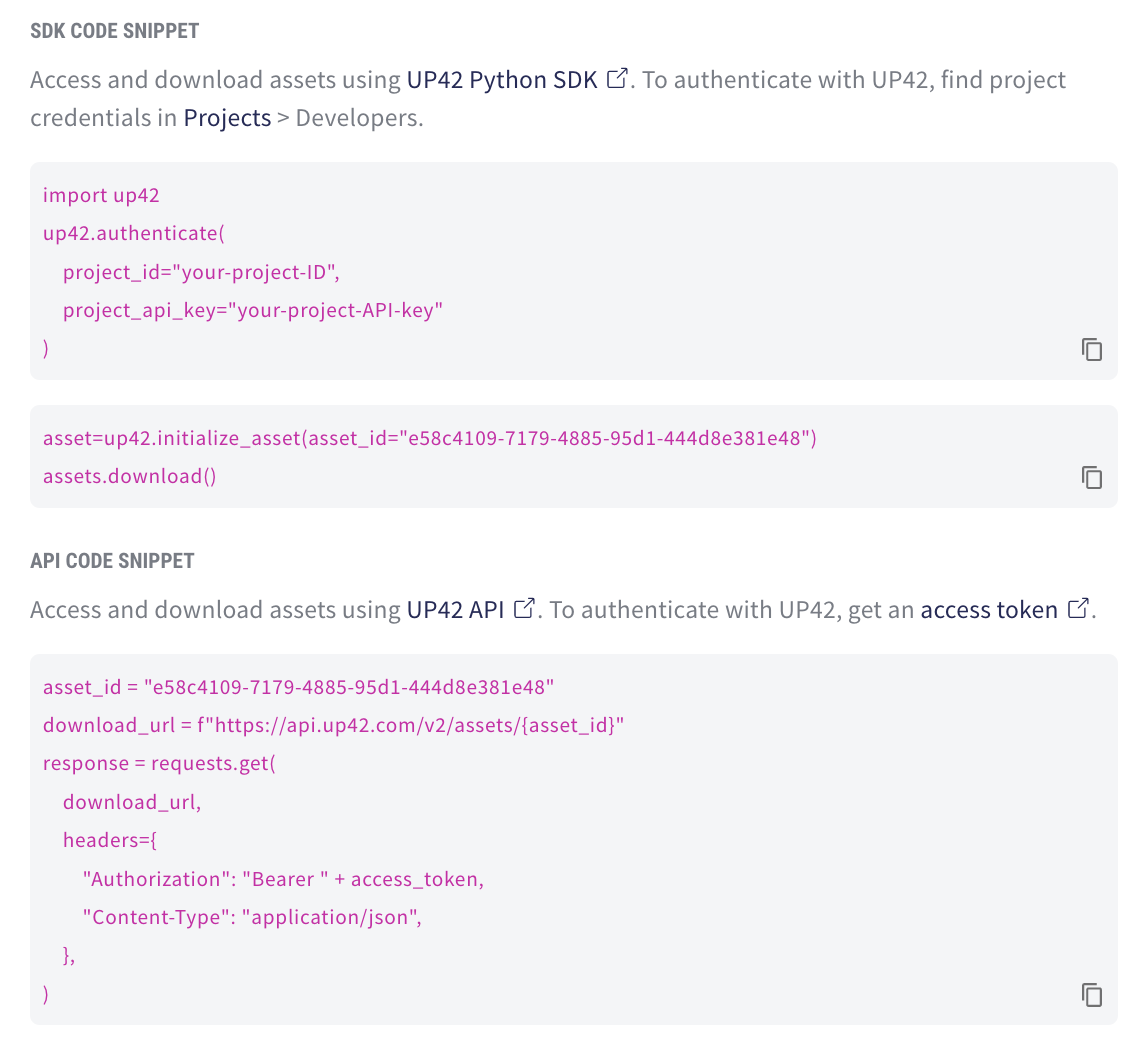
Check out our new storage features.
Place multi-geometry tasking orders on the console
FeatureTaskingYou can now place tasking orders containing multiple geometries through the console. When you upload a geometry file that contains multiple features, the individual geometries will be detected, split, and marked as separate items. When you submit the order, each geometry file will be created as a separate order in our system. The order configuration will be cloned for all orders, saving you the hassle of placing multiple orders for different geometries.
Place your tasking order through the console.
Sentinel-2 now available on API and console
DataFeatureYou can now access open data directly on the UP42 platform. Sentinel-2 is an Earth observation mission from the Copernicus Programme by the European Space Agency. Access to Sentinel data is free. Its imaging satellites carry wide swath multispectral sensors with 13 spectral bands, acquiring optical imagery at a spatial resolution of 10 m to 60 m over land and coastal waters. The mission provides global coverage and a 5-day revisit rate.
Place your order through our console or via our API.
Hexagon’s aerial data program now available on API and console
FeatureDataBefore we head into the well-deserved Easter break, we have some exciting news to share. We now have aerial data from Hexagon on the UP42 platform. The HxGN Content Program offers a large library of RGB imagery with 15 cm and 30 cm GSD in GeoTIFF across North America and Europe.
You can find coverage for all three products in our technical documentation or see our marketplace for more information.
Bringing STAC to UP42 storage
FeatureData managementThe geospatial industry has exploded over the past few years and with it, the number of image providers and data volume. SpatioTemporal Asset Catalog (STAC) is a specification designed to establish a standard in exposing geospatial data, simplifying data management for providers, developers, and users. It allows searching across multiple providers for geospatial assets which share a common structure and set of metadata. Today, UP42 is further strengthening its commitment to the STAC standard by integrating STAC in the UP42 storage and ensuring a common metadata format across providers.
We now provide a STAC API endpoint for asset searches in the UP42 storage. UP42 will extract the metadata for your geospatial assets from existing user storage and make them searchable through our STAC asset service. You can search by AOI, cloud cover, acquisition date, order ID and much more.
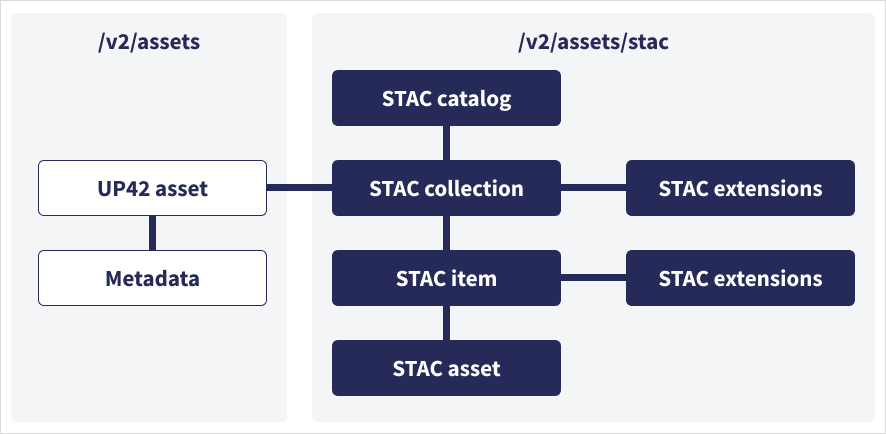
Read more about the STAC specification and methodology here or explore our storage capabilities.
NEXTMap® elevation data suite available on API and console
DataFeatureIntermap’s 3D foundation layers provide the framework necessary for precise spatial analysis and informed decisions. We are happy to share that search, estimation, and ordering of NEXTMap One, NEXTMap 6 and NEXTMap 10 data as DSM, DTM and combined DSM and DTM products are now available on the UP42 platform. NEXTMap DSM contains elevations of natural terrain features including vegetation and cultural features such as buildings and roads; while DTM provides elevations of the bare earth where surface features such as buildings, vegetation and other infrastructure have been removed.
Place your order through our console or via our API.
View feasibility study results for your order directly on the UP42 platform
FeatureTaskingTasking now includes a Feasibility tab to show the results of your order’s feasibility study. When the feasibility study is ready, you will receive an email notification. Follow the link in the email or go to Tasking -> My orders -> Feasibility to see the study results presented as options.
Choose the option that best suits your project needs. That's it. You are now one step closer to activating your tasking order.
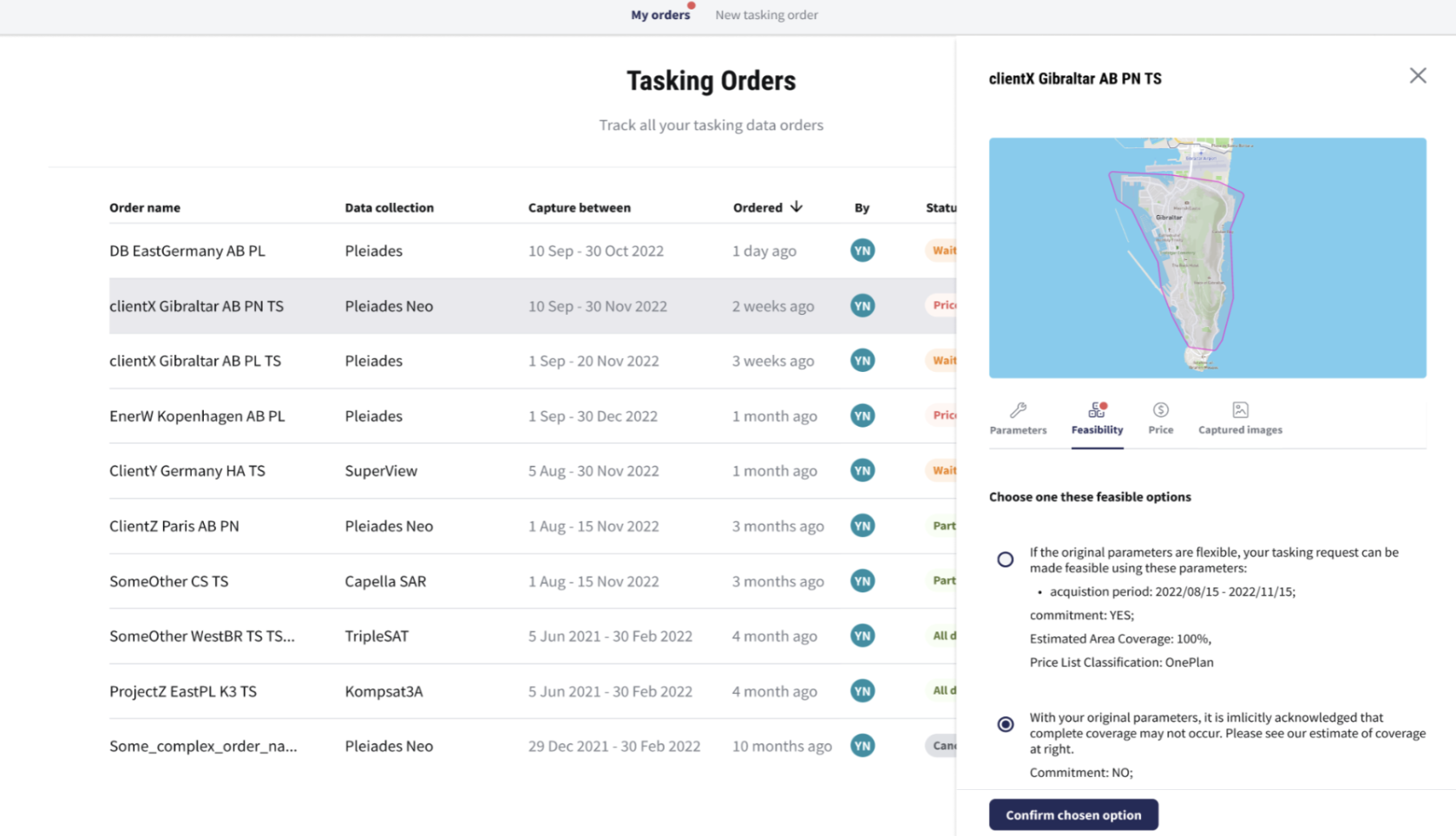
Check out this new feature here.
UP42 storage: now with search and filter functionality
FeatureJust two week into 2023, and we already have some exciting news to share. In line with our commitment to keep enhancing your data management capabilities, you can now search by title, order ID and name in the UP42 storage, as well as filter for collection, producer, tags and source. Filter options are currently available for API only and will be brought to the console for you soon.
WorldDEM™ Neo available on API and console
DataFeatureWe now have elevation data on the UP42 platform. WorldDEM™ Neo offers a high-resolution digital surface model with 5 m pixel spacing and global geographic coverage. Search, estimation, and ordering of WorldDEM™ Neo data are now possible through the UP42 console and API.
Place your order through our console or via our API.
Say hi to our brand new storage!
FeatureAs a user of geospatial data, you've probably faced the challenge of obtaining, organising, storing and sharing your data. At UP42, we're always looking for ways to empower you to easily access and analyze geospatial data. Today, we're taking the next step in enhancing your data management capabilities on our platform, and we have some exciting news to share.
- You can now give your assets custom titles and tags by updating their metadata
- You can also easily sort your assets by name, title, provider, collection and creation date
- You can now list all your assets with their metadata, as well as download them, both from your workspace or your account

Check out what’s new in storage.
Thanks for reading. We’ll have more updates for you soon.
A new way to keep you informed
FeatureWe are always looking for ways to help you navigate the UP42 platform more easily. Today, we are introducing a new console notification center and feed, giving you a single location to find the latest updates when you need them. Inside the center, we've already categorized all notifications for you, so you can easily filter them by category (account, news, storage, and tasking) or read/ unread status.


Pléiades Neo Analytic is now available on API and console
DataFeaturePléiades Neo, the most advanced optical constellation from Airbus, is now also available as an Analytic product on the UP42 console and API, offering true reflectance values. Pléiades Neo Analytic contains 2 different image files per capture, each with a native resolution of 30cm. Place your order through our console or via API today.
All tasking actions under one tab
FeatureTaskingLooking to place a tasking order or monitor the status of your request? Discover all the possible actions and latest information under our new tasking tab.
Use our new tasking order tab to place an order. Simply draw/ upload your AOI, select the tasking collection and fill out the form. You can also get an overview of all your tasking orders here. Click on an order to view more information such as the AOI, order configuration and status of delivered data.


Watch this space for more tasking actions coming soon!